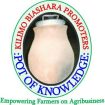Maize is more than just a staple food in Kenya—it’s a cornerstone of the country’s agricultural landscape and diet. As Kenya’s most important crop, maize farming plays a crucial role in food security, livelihoods, and the economy. This blog explores the significance of maize farming in Kenya, the farming practices involved, the challenges faced, and the opportunities for growth in this vital sector.
The Importance of Maize in Kenya
Maize is deeply ingrained in Kenyan culture and cuisine. It forms the basis of many traditional dishes and is a primary source of calories and nutrition for millions of Kenyans. Beyond its dietary significance, maize farming is a key livelihood for smallholder farmers across the country, especially in regions like Rift Valley, Eastern Kenya, and parts of Central Kenya.
Economic Role:
- Employment: Maize farming supports thousands of farming families and laborers, contributing to rural employment and income.
- Trade: Kenya is both a producer and consumer of maize. Surplus production is often sold in regional markets, impacting local and national economies.
Climate and Soil Requirements
Maize thrives in a range of climates but performs best in areas with moderate temperatures and adequate rainfall. The ideal conditions include:
- Temperature: Maize grows well in temperatures between 18°C and 27°C. Extreme temperatures can adversely affect growth and yield.
- Rainfall: Optimal rainfall for maize ranges from 800 mm to 1,200 mm annually. Both too much and too little water can impact yields.
- Soil: Well-drained, fertile soils with a pH of 5.8 to 7.0 are ideal for maize cultivation. Loam soils are particularly suited, but maize can also grow in clay or sandy soils with proper management.
Farming Practices and Techniques
Successful maize farming involves a combination of traditional knowledge and modern practices. Here’s an overview of key practices:
**1. Land Preparation:
- Clearing and Tillage: Proper land preparation involves clearing weeds and debris and plowing the soil to create a fine seedbed. This helps in root development and nutrient uptake.
**2. Planting:
- Timing: Maize is typically planted at the beginning of the rainy season to ensure adequate moisture for germination.
- Spacing: The recommended spacing is 75 cm between rows and 25-30 cm between plants within the row. This spacing allows for optimal growth and reduces competition for nutrients.
**3. Fertilization:
- Nutrient Requirements: Maize requires a balanced supply of nutrients, including nitrogen (N), phosphorus (P), and potassium (K). Fertilizer application should be based on soil testing to determine nutrient deficiencies.
- Application: Fertilizers are often applied in two or more stages, including basal application before planting and top-dressing during the growing season.
**4. Pest and Disease Management:
- Common Pests: Maize is susceptible to pests such as the fall armyworm, maize weevil, and stem borers. Integrated pest management (IPM) practices, including the use of resistant varieties and biological control, are crucial.
- Diseases: Key diseases include maize lethal necrosis (MLN) and gray leaf spot. Proper crop rotation, disease-resistant varieties, and timely fungicide applications can help manage these threats.
**5. Irrigation:
- Supplementary Irrigation: In regions with irregular rainfall, supplementary irrigation can improve yields and reduce the risk of crop failure. Drip or sprinkler systems are commonly used.
Challenges Facing Maize Farming
Despite its significance, maize farming in Kenya faces several challenges:
**1. Climate Change:
- Unpredictable Weather: Variability in rainfall patterns and increasing temperatures can affect maize yields. Adapting to climate change through resilient varieties and improved water management is crucial.
**2. Pests and Diseases:
- Invasive Pests: The spread of invasive pests like the fall armyworm has led to significant crop losses. Effective pest control measures and early detection are essential.
**3. Soil Degradation:
- Erosion and Nutrient Depletion: Intensive maize cultivation without proper soil management can lead to erosion and nutrient depletion. Practices such as agroforestry, cover cropping, and soil conservation are needed to maintain soil health.
**4. Market Access:
- Price Fluctuations: Farmers often face fluctuating maize prices, which can impact their income. Improving market access, storage facilities, and value addition can help stabilize incomes.
Opportunities for Growth
Despite the challenges, there are significant opportunities for advancing maize farming in Kenya:
**1. Research and Innovation:
- Improved Varieties: Investing in research to develop high-yielding, drought-resistant, and pest-resistant maize varieties can boost productivity.
- Technology Integration: Adopting modern technologies, including precision farming tools and data analytics, can enhance efficiency and yield.
**2. Sustainable Practices:
- Conservation Agriculture: Practices such as minimum tillage, crop rotation, and agroecological approaches can improve sustainability and resilience.
- Water Management: Implementing efficient irrigation systems and water conservation techniques can address water scarcity issues.
**3. Value Addition:
- Processing: Developing maize-based products such as flour, snacks, and animal feed can create additional revenue streams and reduce post-harvest losses.
- Export Markets: Expanding into regional and international markets can provide new opportunities for Kenyan maize farmers.
Conclusion
Maize farming in Kenya is a vital component of the country’s agricultural sector, with deep roots in cultural and economic contexts. While challenges such as climate change, pests, and market fluctuations exist, the sector also holds immense potential for growth and improvement. By embracing innovative practices, investing in research, and focusing on sustainability, Kenya can enhance its maize production and continue to secure its role as a key player in food security and agricultural development.



